Microsoft's Percentage of Women Drops
Microsoft just issued its latest diversity numbers, and while the number of women and underrepresented groups in key areas has risen over the past year, the company also experienced an overall decline in its percentage of women employees. In the twelve months leading up to September 2015, the percentage of women at Microsoft declined from 29 percent to 26.8 percent. In a corporate blog post explaining the data, Microsoft blamed this reduction on “the restructure of our phone hardware business,” which impacted factories outside of the U.S. that produce smartphones and other equipment: “A higher percentage of those jobs were held by women.” Microsoft claimed gains in “nearly all racial and ethnic categories,” with the exception of American Indian/Native American and Pacific Islander, which remained flat. The percentage of women in leadership roles at Microsoft currently stands at 27.2 percent; the company’s board features three female members (out of 11), up from two a year ago. The percentage of African-American/black and Hispanic corporate vice presidents has increased from 4.5 percent to 6.4 percent over the past 12 months. Microsoft is also attempting to adjust its pipeline of new recruits with an eye toward increased diversity. Worldwide, the percentage of women university hires increased from 27.7 percent to 30.6 percent over the past year. The numbers of women and underrepresented groups heading from school into engineering positions at the company likewise rose during the same period. “If current trends hold,” the blog posting added, “We expect to see a continuation of growth in all these areas as we move through our fiscal year (which ends on June 30, 2016) and into the first quarter of FY17.” At the same time, however, the company acknowledges that it still has work to do if it wants to “improve workforce representation.” A recent study by the University of California, Davis, suggested that, although many tech firms have pledged to make their executive boardrooms more diverse, relatively few women have ascended to their companies’ respective boards; women directors constituted 15.5 percent of corporate boardrooms among software companies surveyed. That’s just one of the many challenges facing tech companies as they attempt to diversify their employee demographics.



